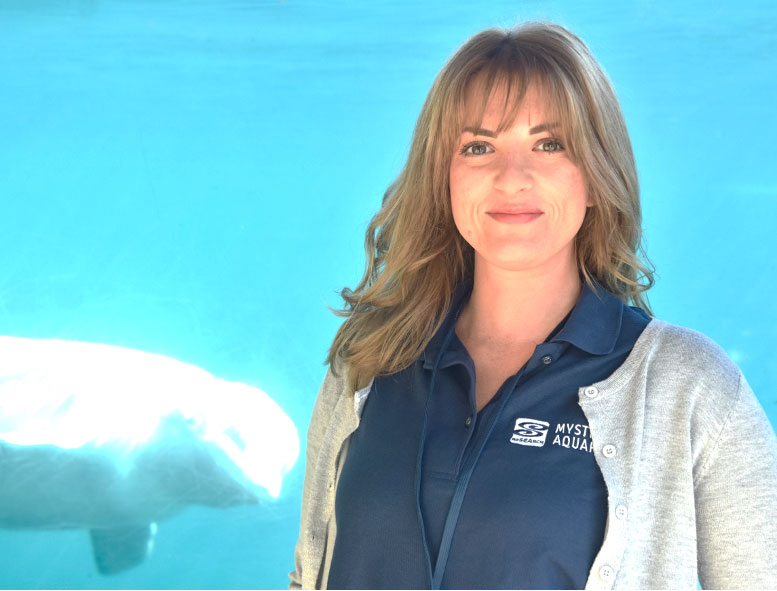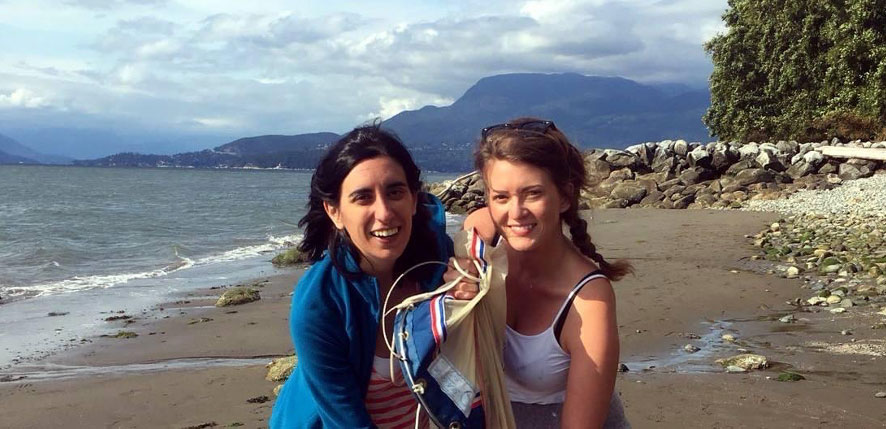By Ewaldo Leitao.
Dr. Susan Smith graduated in December 2020, during the pandemic, from UConn Avery Point with Dr. George McManus. Her work focused on the ecology and molecular biology of marine ciliates (a kind of eukaryotic microzooplankton). During her PhD, Dr. Smith (Sue) discovered a new genus and species, published the first tintinnid ciliate genome, and formed lasting collaborations with some remarkable scientists. Susan is currently a research scientist at the Mystic Aquarium, where she studies the microbiome of beluga whales.
Q: Tell us a bit about the research you have done during your PhD.
Sue: While at UConn, I had the opportunity to take part in every facet of research—we would take a boat into the Atlantic and sample, bring them back to the lab and do microscopical and experimental work, and then use those same cultures for downstream genomic and genetic analyses. We would often do what my mentor would call “old world” microscope work, but would then take that same single cell and sequence its whole genome, all in the same lab. That kind of work that runs the full gamut of biological research is so rare today, but was such a valuable experience, and really allows you to understand your subject. I think the UConn Marine Sciences Department presents that opportunity far more than your average academic research setting, which is especially important for graduate students.
I actually had the good fortune of doing my B.Sc., M.S., PhD., and my Postdoc at UConn Avery Point (I’m a bit of a stubborn forever-student). I finished my postdoc two months ago (~1.5 years in) and immediately started my new position as a research scientist at Mystic Aquarium (luckily our labs are on the Avery Point campus so I get to keep my parking space and continue my path towards being a permanent fixture on campus).
Q: You’ve had the opportunity to teach during your postdoc. How was your teaching and postdoc experience?
Sue: I had the great pleasure of filling in for my (lifelong) mentor and graduate advisor Dr. George McManus when he was on sabbatical, which allowed me to teach his graduate course, Biological Oceanography. Teaching Bio Oce was a unique opportunity to work with higher level students that were serious about their graduate/educational career, and I valued and enjoyed that immensely. Luckily, even with my full time research position at Mystic Aquarium, I get to keep an appointment at UConn, and am scheduled to teach Marine Biodiversity and Conservation this spring semester (still seats left!). I’m extremely grateful to remain a part of both scientific communities.
Continuing a postdoc position in the same lab I did my PhD in allowed me to complete projects I was excited but over-zealous about during my PhD, and also allowed me the autonomy to ask new questions that were a little off track from the direction of the lab. Of course, there’s a major benefit in going to a different lab for your postdoc, especially if you want to change course on your research goals, but these days most PhDs end up doing two postdocs before finding a faculty position, so it’s something to consider.
Q: How did your previous work align with your current job in the aquarium? What are you doing now and what have you planned to do in the aquarium?
Sue: The postdoc project I was most enthusiastic about involved these unique ciliate species that live in cetacean blowholes (as a part of their natural, healthy microbiome). Admittedly, this project all started as a blatant excuse to collaborate with Mystic Aquarium and interact with the beluga whales there. I worked with some REU students (Research Experience for Undergraduate students) during the summers to investigate this more. The major benefit of this work was that it formed a collaboration with Dr. Tracy Romano (VP and Chief Scientist of Research at Mystic Aquarium). Today, my work at Mystic Aquarium largely surrounds host-associated microbiota. To be in a position where you have so many samples and project options that you can’t decide which grant proposal you’re most excited to write, is a great feeling. I also now contribute to weekly sampling efforts, so I get to hang out with whales every week—that’s pretty awesome too.
Part of my work today focuses on how the microbiome of a new animal host changes as they are introduced to a different host population. I also have some other fun projects going on, including genetic sexing of penguins, microbiome analyses in sea turtles, and stress-response tests in stranded seals. In general, my research is focused on answering these questions using non-invasive methods that not only avoid stressing the animals, but also can be used in the conservation of wild populations that are impossible to have close contact with
Q: What is the best part about working in the aquarium?
Sue: The best part about working in the aquarium are my colleagues. It quickly became clear that every veterinary staff member, animal husbandry professional, and researcher, are concerned with animal welfare above all else. Further, all Mystic Aquarium research has an application in the conservation of wild (often endangered) populations, and even non-invasive interactions with our animals are extremely regulated, as they should be. Additionally, and although lesser known, MA also puts an enormous amount of effort and resources into our stranding clinic, from seals to sea turtles, where the rapid recovery and release of these animals is of highest priority. These stranders also allow for some opportunistic (non-invasive) research sampling that can go a long way in identifying threats and diseases afflicting wild populations.
Q: Do you have any hobbies and/or activities you do in your free time?
Sue: This question would have worried me as a graduate student, since any energy put towards extracurricular activities would have been an unthinkable waste of time. However, I’m grateful that my current position is structured in a way that prioritizes a separation between work and home, which is something I didn’t realize I needed. Today, I’m happy to spend nights reading some old science fiction novel with a glass of red wine and dogs by my side. However, I also truly get pleasure from my work and will gladly spend a Saturday at a coffee shop with a (likely late) manuscript.


